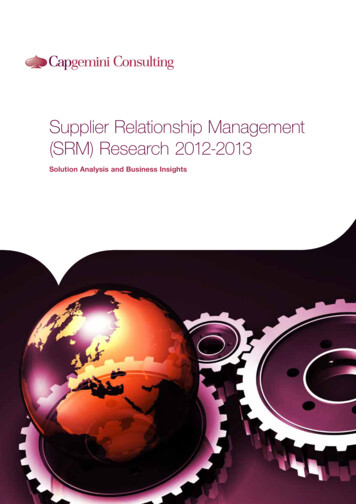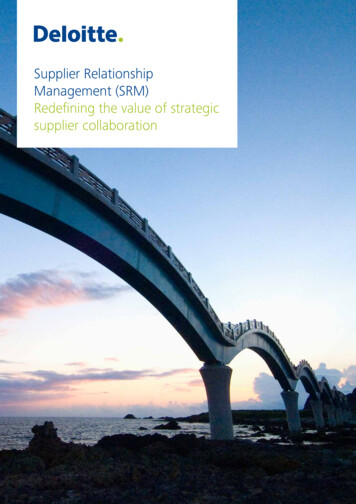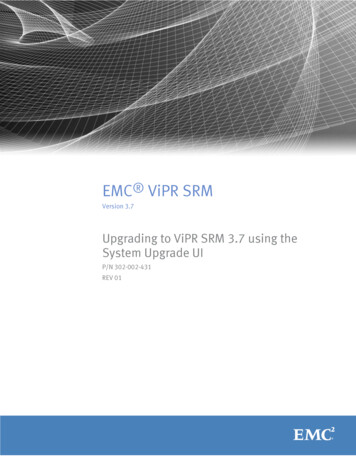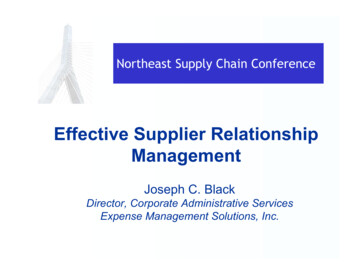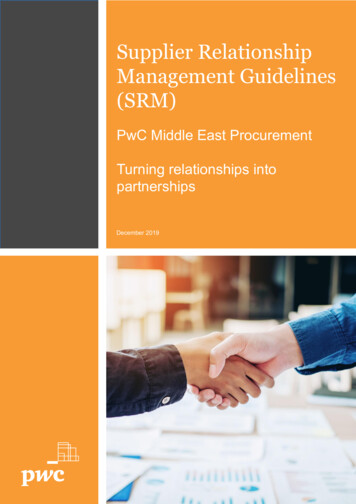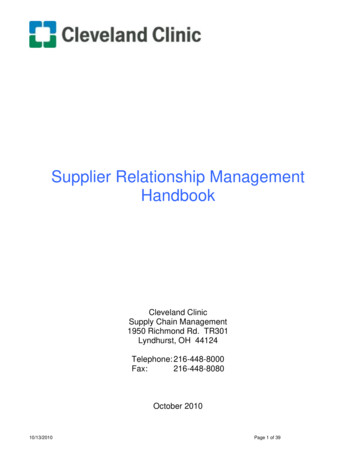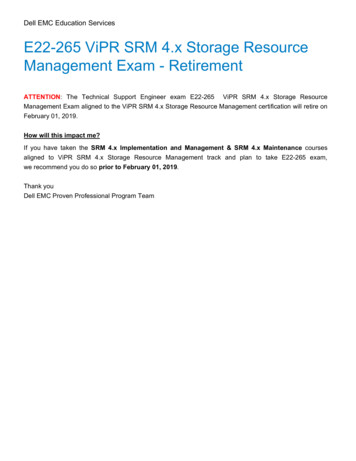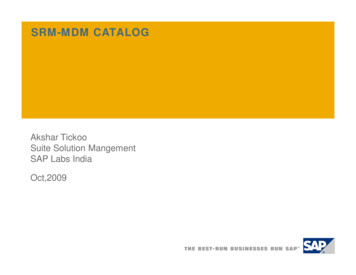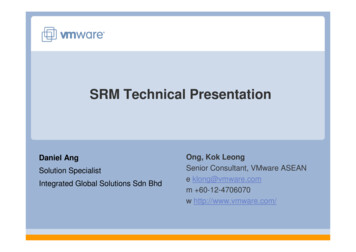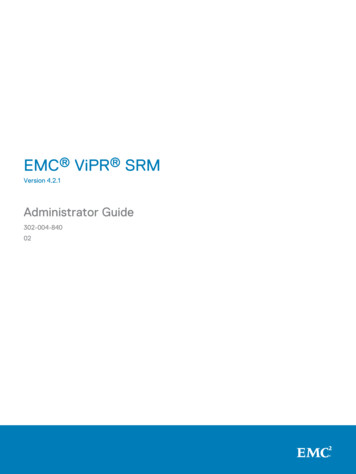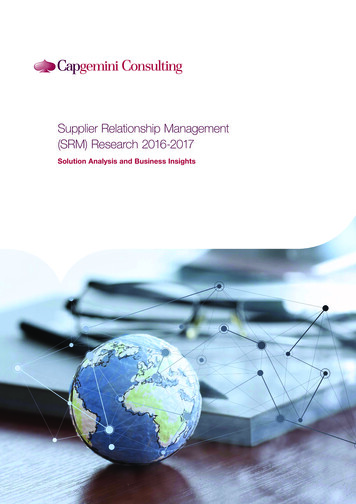
Transcription
Supplier Relationship Management(SRM) Research 2016-2017Solution Analysis and Business Insights
Prepared and edited by:Bauke Vogelzang KuipersRobin AdriaansTon van DolderLeon FleurenErick HaagArjan de KokJeffrey de VisserTim WijnsmaSilke PentermanSarissa AlleijnA note of thanks .Capgemini Consulting would like to extend its thanks to the vendors who made time toparticipate in the Supplier Relationship Management Survey. Without their cooperation andsupport, research of this nature would not have been possible.
ContentsForeword05Business Insights 07Functionality Analysis 21Vendor Profiles 52
04
Supplier Relationship Management (SRM) Research 2016-2017ForewordSince our last Supplier Relationship Management (SRM) survey, the market for SRM applications has changed with the most important trendsbeing the strong push towards the cloud and greatly increased usability with mobile applications. It is interesting to see that since the first study,which we did more than 14 years ago, the market for SRM is still growing and improving. We hope this study can again help you, as a procurementprofessional, to maneuver the SRM applications landscape just like the first study did.In the first section our procurement professionals share with you three focus areas for development in the SRM environment. The first addresses theFuture Value Chain and how global developments in Supply Chain Management impact SRM. The second addresses the role of SRM in creatingcompetitive advantage and the third addresses new digital technologies in SRM for collaboration.The second part of the study analyses the results of the SRM functionality survey. The analysis is based on a series of questions related to ourprocurement process model and designed to assess whether the software covers a specific set of functions within the SRM environment. In line withour previous editions, we want to ensure that the survey evaluates the market to a level of depth and completion, required to present the relativestrengths/weaknesses of the vendor landscape accurately.In addition to the previous SRM surveys, we assess the level of support in Supplier Data Management and Product Lifecycle Management. Wesee an increasing need for Procurement to be involved in product design, and be the linking pin for early supplier involvement and collaborationto maximize value from the supply chain. To tackle this new role, procurement professionals need new functionalities to support them in theircollaboration with suppliers. These functionalities are currently delivered primarily by Procurement Lifecycle Management (PLM) vendors, but we seean increasing number of SRM providers expanding the scope of their solutions towards these collaboration focused functionalities.The last part of our research consists of the Supplier Profiles in which we have given our independent view on the different vendors. We have learntfrom previous client engagements that this is valuable information for SRM software selection initiatives.Our procurement experts have worked on this study with great pleasure. We hope you find the study useful to further develop your supplymanagement function and look forward to your input and commentary. We certainly hope to hear those comments through one of our many digitalmediums such as the Capgemini Procurement Transformation Blog.Ton van DolderSupply Chain Management practice lead the NetherlandsCapgemini ConsultingErick HaagProcurement Transformation lead the NetherlandsCapgemini Consulting05
06
Supplier Relationship Management (SRM) Research 2016-2017Business Insights07
The Future Supply Chain and the role of ProcurementThe new economic realityrequires procurementto shift focus towardssupply chain value and riskmanagementThe supply chain in all industries israpidly changing due to globalizationand other economic, social andtechnological developments. In thecartoon below we have pictured ourvision on the capabilities that arerequired for organizations to cope withthe challenges of the future supplychain.Four mega trends are driving thesechanges and the role of suppliers inglobal supply chain management:08 Digital world - accelerateddigitization and technologicaladoption enable superiorcollaboration and communicationacross the supply chain resultingin improved reliability, agility andeffectiveness Differentiated customer experience- customization and personalizationof products/services require toleverage the innovative power of thesupply chain Fight for resources - scarcity ofnatural resources and volatile supplymarkets put pressure on the agilityof the supply chain and requiresinnovative risk mitigation strategies Persistent threat of insecuritydue to political instability, globalsecurity threats, financial crisis andenvironmental considerations cancause sudden constraints in thesupply chain.Leading organizations are re-thinkingthe role of procurement and SupplyChain Management in order totransform traditional supply chainsinto flexible, agile and resilient digitalsupply chains. They change theirapproach from cost management tovalue creation. Supplier RelationshipManagement and maintaining suppliernetworks are critical factors in thistransformation.
Supplier Relationship Management (SRM) Research 2016-2017How do these trends influence therelationships with suppliers? And whatare the implications for procurement?Digital worldTechnology is the biggest influencerof today’s business and impactsevery facet of the end-to-end supplychain. Cloud technologies, mobileapplications, social media, and bigdata are buzz words that representapplications of digital technologiesthat can be disruptive as well as akey differentiator for the supply chain.Machine to machine communicationsupported by integrated sensors hasaccelerated production and logisticalprocesses. Extensive information accessible via digital (cloud) platformsand social media - has increasedtransparency of the complete valuechain. It enables improved decisionmaking resulting in improved reliability,agility and effectiveness.Other technologies that are changingthe supply chains drastically are dronesand 3D printing. Companies are not onlyexperimenting with last-mile delivery bydrones, but also with applications forsafety inspections, network connectionsor agricultural purposes. 3D printinghelps to eliminate the stock of spareparts leading to reduced costs, risksand improved cash flow. It can also beused for rapid prototyping or reverseengineering reducing developmentcosts and increasing time-to-market.With the rise of the digital world,companies are becoming moreand more dependent on theirsuppliers. Supplier collaboration andcommunication is becoming a keychallenge for the procurement function.This requires the ability of procurementto develop and manage the suppliernetwork and safeguard its agility. Theprocurement function needs to havethe ability to ‘consume’ and leverageavailable data, e.g. to scout forapplication of new technologies andsupport the business to assess thepossibilities and/or impact.Similar to the customer journey,procurement needs to identify the‘moments of truth’ for strategicsuppliers in operational, tactical andstrategic collaboration. This will bringfocus to the right improvement areas forbecoming a partner of choice.Differentiated customerexperienceFight for natural resourcesToday’s customers are well-informedand more demanding. At the sametime disruptive start-ups can rapidlybuild new products and services byusing free digital tools and shake up themarket. An example of such a disruptivestart-up is the dutch company Blendle.Blendle provides a online news platformwhere users can search and readarticles from a variety of newspapersand pay per article. Many customerscancelled their subscription(s) tonewspapers and switched to Blendle. Italso attracted new customer groups topay for news articles.Companies recognize the pressure tocustomize and personalize productsand services. To be innovativeand deliver distinctive customerexperience a company should havethe digital capabilities to interact withtheir customers through a variety ofchannels. They need to understandthe customer journey and continuouslylive up to customer expectationsand promises. From a supply chainperspective, this requires operationalexcellence and optimal collaborationwith the supplier network. To realizethe maximum added value from thesupply chain, companies want tobecome the customer of choice fortheir most important suppliers. Withoutthe cooperation of the publishers andjournalists Blendle cannot deliver anycontent to its users.World’s natural resources are undersevere pressure by global populationgrowth, fast-growing emergingeconomies, and other demographicpressures. Consequently, food andenergy prices are rising and demandfor fresh water has been steadilyincreasing. Some countries are buyingmining rights for rare earth elementsin cases where resources are found inlimited number of countries, which canrestrict supplies at will.Typical for today’s challenge is thevolatile market fluctuation of thesenatural resources as well as theirderivatives. The role of procurementis to understand the drivers thatinstantly can change the demand fornatural resources. They not only needto understand the quota of naturalresources in the purchased productsbut also have market intelligence onneighboring supply chains that use acommon supply base.09
Leading organizations use the followingprocurement strategies to mitigate therisk of insufficient supply: Build up global know-how onalternative sources for materials attimes of uncertainties Develop alternative productstrategies in line with persistentsupply insecurities, to offset loss ofbusiness traction in such markets Applying circular economyprinciples, e.g. sourcing secondaryraw materials and using renewableprimary materials Investing in and developingnew capabilities with strategicpartners (e.g. early market/supplierengagement) Partnering with local suppliers inthe supply chain, providing microfinancing to local suppliers thatjointly develop local economies andsecure supply of goodsA growing number of innovativetechnological solutions are availablewhich support the supply chain functionwith data analytics and scenario basedsimulation techniques.Persistent threat of insecurityRecent headlines in the news arecovered with examples of politicalinstability, global security threats,financial crisis and natural disasters.All these political and macro-economicfactors pose a persistent threat to thesupply chain, affecting globally spreadbusinesses. Economic sanctions orimport restrictions to protect nationalresources lead to sudden increase ofcosts and lead-times.An advanced risk management processis key to an agile supply chain. Analyticsmust be the balancing factor that takesthe increasing complexity and volume ofdata and distils it into actionable insightto secure the supply chain effectively.10A second strategy to bring agility tothe supply chain is to introduce localsupplier innovations to the localizedproduct strategy. Especially in emergingmarkets the usage of local suppliersincreases cost effectiveness of thesupply chain.Looking forwardThe developments in global marketsrequire supply chains to becomeflexible, agile, resilient and digital.Capgemini Consulting helpsorganizations with this transformationby providing six core capabilities for thefuture supply chain: Supply Chain Strategy and TargetOperating Model - strategy andoperating model adapted to therequirements of areas such asomni-channel fulfillment and globalresilience. Digital Supply Management complete and real-time insight intothe value-added, costs and risks ofsuppliers and supply chain partners. Omni-Channel Fulfillment - delivergoods quick and efficient to endcustomers through all availabledistribution channels E2E Visibility - understand andcontrol the end-to-end supply chainacross company boundaries Supply Chain Analytics - toolboxof available (big) data sources anddigital analytics to support the otherfive areas.More than ever before, companiesneed to rely on strong relationshipskills of Procurement to strengthenexisting alliances and forge new ones.The Procurement function is startingto tap into the rich sources of socialmedia to improve the communicationto their supplier network. SupplierRelationship Management tools shouldbe better equipped with functionalitiesfor analytics and supplier collaboration.For this reason our bi-yearly SupplierRelationship Management researchhas been extended with thesefunctionalities. Collaborative Planning - demandand supply planning based onplanning and real time productiondata of partners in the supply chainSupply Chain Strategy & Target Operating ModelDigital SupplyManagementCollaborativePlanningE2E VisibilitySupply Chain AnalyticsOmni ChannelFulfillment
Supplier Relationship Management (SRM) Research 2016-2017Digital Supply ManagementCreating competitive advantage through the supply baseFigure 1 - Capgemini Supply Management Excellence FrameworkBusinessIntegration LayerAnalytics &Insights LayerOperationalExcellence Layer“Front Office”“Middle Office”“Back Office”SUPPLIER INNOVATIONMANAGEMENTDESIGN FOR EXCELLENCETOOLSCOLLABORATIVE COMMODITYMANAGEMENTBPO / SSC MANAGEMENTRISK & PERFORMANCE MANAGEMENTProcurement valueBecoming a partner of choiceFrom cost and category managementto value and relationship managementWhat leading organizations do differentlyCentralizing, standardizing, andoutsourcing transactional procurementactivities is just the beginning of amore strategic procurement function. Itoffers procurement organizations timeand resources to focus on developingand maintaining relationships withstrategic partners. But how do theyengage with their suppliers in orderto maximize value? Which suppliersprovide a competitive advantage?Which offer the opportunity to reallyadd value to both the business as wellas
Since our last Supplier Relationship Management (SRM) survey, the market for SRM applications has changed with the most important trends being the strong push towards the cloud and greatly increased usability with mobile applications. It is interesting to see that since the first study, which we did more than 14 years ago, the market for SRM is still growing and improving. We hope this study .
